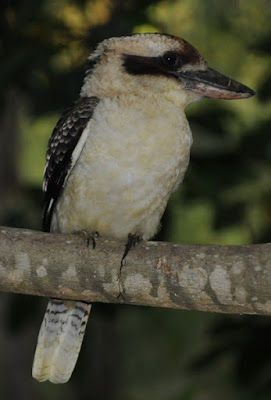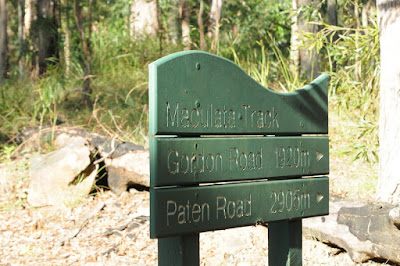For my last posting about my 2011 return to Australia I offer a miscellany of birds (and other things) from the woodlands around Brisbane - starting with another look at Australia's most iconic bird (well, I think so) and ending with one that means a great deal to me.
Even if you do not find the Laughing Kookaburra (Dacelo novaeguinae) iconic, I hope you will agree that it is entertaining! This young bird did not seem the least concerned about being stalked by an eager ornithologist - Australians are, after all, a laid-back lot.
Even adult Kookaburras do not seem particularly perturbed by a human presence. I suspect they know that, being the world's largest kingfishers and fairly aggressive characters in their own right, there is not much able to take them on.
Their territorial call, the famous 'laugh', used to be a standard background noise in Hollywood jungle movies, despite the fact that this species of kookaburra at least is neither tropical nor a haunter of jungles (the other three species of Dacelo, one in northern Australia and two in New Guinea and surrounding islands, are indeed tropical or subtropical birds, as is their peculiar New Guinea cousin the Shovel-billed Kookaburra (Clytoceyx rex), a bird with a broad spade- shaped bill that it uses, among other things, to dig up earthworms).
As we watched the kookaburras, a trio of Australian King Parrots (Alisterus scapularis) flew in to the eucalypts above us. None was an adult male - the males are brilliant birds, with bright red heads and underparts - but these females are attractive enough.
For most people, I imagine, spiders are less attractive than parrots and kookaburras, but the Golden Orb Weaver (Nephila edulis) is nonetheless a pretty spectacular creature. It is common around the Brisbane area.
This enormous female has trapped a Monarch (Danaus plexippus); notice the comparatively tiny males waiting in the wings.
On April 9, after our successful morning excursion to Boondall Wetlands and Tinchi Tamba (see previous post), Lawrence and I drove to the popular overlook at Mount Coot-Tha, in the hills west of the city.
This was mostly for scenery, but I did take a short uphill walk on the Maculata Track in search of butterflies and birdlife.
This pretty little butterfly is an Orange Ringlet (Hypocista adiante), a Satyrine...
... and this is a White Migrant (Catopsilia pyranthe), a Pierid. Yes, I know, it's yellow - this is one of its colour forms.
Usually I am apologetic if I cannot identify a butterfly, but in this case the butterfly in question may simply not be identifiable. Acording to Don Herbison-Evans there are several species with uppersides pretty much exactly like this one, and to be sure which one this is I'd have to turn it over - not an option for a photograph, I'm afraid.It might possibly be a Rayed Blue (Candalides heathi).
At the top of the hill I found a party of fairy-wrens on the rank grass along the trail edge.
I wasn't sure what sort of fairy-wren I was seeing until a gorgeously-plumaged male popped into view. Then there was no question - no other fairy-wren looks even remotely like the Red-backed (Malurus melanocephalus), a mostly tropical species near the southeastern end of its range around Brisbane. This is presumably a dominant older male; at this time of year younger males would have already moulted into a dull, female-like eclipse plumage.
As I mentioned in my post on the Blue Mountains, Australian treecreepers (Climacteridae) were the subject of my doctoral studies - and thus the direct reason (or excuse) for my two years' residence in Australia in 1972-74. I have, as a result, an inordinately soft spot for them, and no bird could have made a better finish to my sojourn in Brisbane than this White-throated Treecreeper (Cormobates placens).
Treecreepers may seem drab, but they are extremely interesting birds. Their way of life is not an easy one. Climbing up a vertical surface is no easy task, and unlike the northern treecreepers (Certhiidae), or woodpeckers - birds entirely absent in Australia - the Australian birds manage it without relying on stiffened tail feathers for support. Instead, they cling to the trunk with enormous, strong feet and long, sharply-curved claws.
Much of their weight is borne by the long, straight hind toe, and in the anatomical part of my doctoral researches I found that the ungual phalanx - the main bone in this toe - is unusually strengthened. It is thick and almost straight, unlike the thinner, curved bones on the hind toes of other songbirds, and lacks the excavation at its tip that, in most birds, holds the tendons that elevate the hind claw. Instead they have a special tendon running to the claw from the base of the toe, leaving the ungual phalanx free to develop solidly along the whole of its length and to provide the bird with added support.
Notice the ochre bar on the wing, visible in flight or in display. the White- throated (and its close cousin the Papuan Treecreeper (Cormobates placens) of New Guinea) differs from the other five species in the family, the members ofthe genus Climacteris, in that it rarely feeds on the ground (though it shares its cousins' rather unusual preference for ants, insects fairly few birds eat), and because you usually find them in pairs rather than trios. In the other species, as in many other Australian birds, a young male born the previous year usually helps its parents raise the next generation, but a pair of White-throateds seems to manage on its own. Helping behaviour, a form of cooperative breeding, may have been a feature of the earliest songbirds - a feature that the White-throated Treecreeper appears to have lost.






















